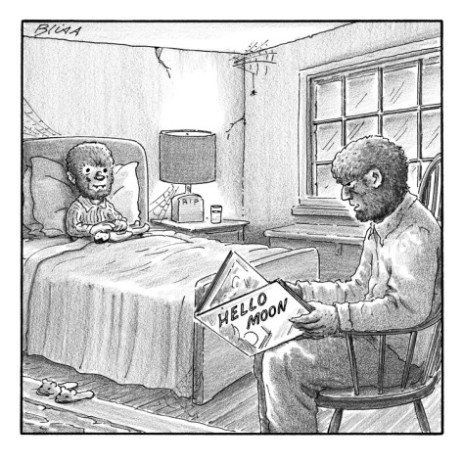
CREDIT: New Yorker cartoon by Harry Bliss, ALL RIGHTS RESERVED. Prints available at condenaststore.com.
EDITOR’S NOTE: Instead of Goodnight Moon by Margaret Wise Brown, this werewolf father reads the lycanthrope version.

CREDIT: New Yorker cartoon by Harry Bliss, ALL RIGHTS RESERVED. Prints available at condenaststore.com.
EDITOR’S NOTE: Instead of Goodnight Moon by Margaret Wise Brown, this werewolf father reads the lycanthrope version.

“To learn to read is to light a fire; every syllable that is spelled out is a spark.” VICTOR HUGO, Les Misérables
Photo: Mia Farrow reads to twins Matthew and Sascha Previn, baby Fletcher Previn, and daughter Lark Song Previn, Martha’s Vineyard, summer 1974, by Alfred Eisenstaedt, Time/Life, ALL RIGHTS RESERVED
In May I think it truly best
to be a robin lightly dressed
concocting soup inside my nest
Mix it once, mix it twice,
mix that chicken soup with rice.
…From CHICKEN SOUP WITH RICE: A Book of Months by Maurice Sendak, available at Amazon.com.
MARCH MADNESS, THE MARCH HARE, AND LEWIS CARROLL
In the U.S., the month of March is filled with talk of madness – March Madness, the NCAA basketball tournaments. Background on how “March Madness” got its name is in an article at Slate.com. After reading this explanation, I must say, “Hmmm,” and ask, “Did the journalist leave out something — or someone?”
I, for one, believe the inspiration for “March Madness” came from the mad March Hare in Alice’s Adventures in Wonderland – and author Lewis Carroll has never received proper credit. Yes, his work is in the public domain (find Alice in many forms at Project Gutenberg) – but he should still receive attribution. (As a cautionary tale, look at what happened to Jane Goodall for not attributing passages in her new book, Seeds of Hope, that she lifted from Wikipedia.)
So, at last, Lewis Carroll (1832-1898) – an author among our top-10 favorites – we will honor you on this day in March 2013, by saying that you and your creation the March Hare are the inspiration for the term “March Madness.”
According to Wikipedia (we promise to try to remember to attribute!), “Mad as a March hare” is a common British expression based on popular belief about the behavior of male hares during breeding season when they run around acting crazy – boxing with other hares, jumping straight up in the air, racing around in circles, and other wild, excitable behavior. (In Great Britain, breeding season for hares lasts from February to September).
In Carroll’s book — originally published in 1865 — the March Hare behaves as though it’s always teatime because his friend, the equally Mad Hatter, “murdered the time” while singing for the Queen of Hearts. (During the 1800s, “mad as a hatter” was a common British expression – referring to the disorientation hat makers experienced from the mercury used in their trade.)
So, today, we honor author Lewis Carroll and especially his charming creation the March Hare. Lets revel here in a few passages from one of the greatest works in all of literature – Alice’s Adventures in Wonderland.
“Have some wine,” the March Hare said in an encouraging tone.
Alice looked all round the table, but there was nothing on it but tea. “I don’t see any wine,” she remarked.
“There isn’t any,” said the March Hare.
“The it wasn’t very civil of you to offer it,” said Alice angrily.
“It wasn’t very civil of you to sit down without being invited,” said the March Hare…
The Hatter opened his eyes very wide…”Why is a raven like a writing desk?”
“…I believe I can guess that,” Alice added.
“Do you mean that you think you can find out the answer to it?” said the March Hare.
“Exactly so,” said Alice.
“Then you should say what you mean,” the March Hare went on.
“I do,” Alice hastily replied, “at least – at least I mean what I say – that’s the same thing, you know.”
“Not the same thing a bit!” said the Hatter.
“Why, you might just as well say that ‘I see what I eat’ is the same thing as ‘I eat what I see’!”
“You might just as well say,” added the March Hare, “that ‘I like what I get’ is the same thing as ‘I get what I like’!”
##
And whenever we pick up Alice’s Adventures in Wonderland and open it to any page, any passage, we get what we like.
Illustration: John Tenniel (1820-1914)